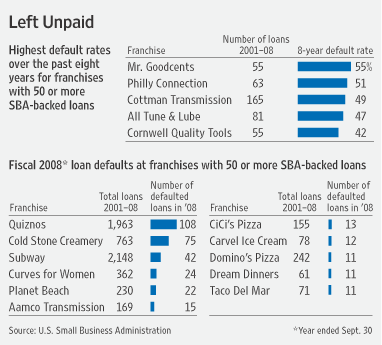Mortgage Defaults Only Part Of The Problem
Mention loan defaults and most people probably think of mortgages. Home foreclosures due to mortgage defaults are getting the bulk of press coverage and the most attention in Washington. The credit crisis, however, is not confined to home mortgages. Lack of consumer demand, reduced incomes, lack of credit and an economy that seems to be getting weaker by the hour, is causing growing defaults in almost every category of lending. Commercial real estate, credit cards, car loans, student loans, second mortgage loans, business loans and personal loans are all defaulting at shockingly high rates that the banking industry never expected. The losses from these loan defaults are depleting bank capital, making banks less eager to lend to anyone.
The Wall Street Journal reports today that loan Defaults by Franchisees Soar As The Recession Deepens.
From ice-cream parlors to tanning salons, franchisees’ defaults on loans guaranteed by the U.S. Small Business Administration are piling up in amounts unseen in years. A list of loans at 500 franchises shows the number of defaults by franchisees increased 52% in the fiscal year ended Sept. 30, 2008, from fiscal 2007. Loan losses totaled $93.3 million, a 167% jump from $35 million just 12 months earlier.
The figures, a stark barometer of the downturn’s severity and scope, could give pause to banks that have loan money about where to lend next. Banks that make SBA-guaranteed loans say they use the annual list as guidance in assessing future commitments.
SBA-guaranteed loans are aimed at providing capital to small businesses that often can’t qualify for conventional credit. Those loans, made through commercial banks and other lenders, can total as much as $2 million for as long as 10 years. The SBA essentially insures a significant portion of the loan to encourage lending and small-business entrepreneurship. The recently passed stimulus package raises that guarantee amount to 90% from 75%.
The franchise brands where at least 11 franchisees defaulted on loans during the 2008 fiscal year were: Aamco Transmissions, Carvel Ice Cream, CiCi’s Pizza, Cold Stone Creamery, Curves for Women, Domino’s Pizza, Dream Dinners, Planet Beach tanning salons, Quiznos, Subway and Taco Del Mar.

Over time, some businesses have significantly better loan-performance rates than others. Among the worst-performing franchise brands, as measured by the percentage of SBA-guaranteed loans issued to franchisees over the past eight fiscal years that defaulted: Mr. Goodcents Subs & Pastas, 55%; Philly Connection sandwiches, 51%; Cottman Transmission, 49%; All Tune & Lube auto centers, 47%; Cornwell Quality Tools, 42%; and Carvel and Blimpie, both with 41% failure rates. Each had obtained at least 50 SBA-guaranteed loans during that period.
An interesting aspect of the default ratio is that certain franchise operations have a huge number of defaults. With more than enough bad debts on the banking industry’s books, one would hope that lending would be severely curtailed or eliminated to franchise operators that are showing over a 40% default rate. A default ratio of almost half of all borrowers would seem to indicate a basic flaw in the franchise system’s business model.
The bottom line for franchise operations and probably every other business right now is that more loans may keep the doors open, but at the cost of burying the business owners in debt and making future profitability all that much more difficult. What businesses really needs right now to survive and prosper is increased sales, something that seems very difficult to achieve under current economic conditions.